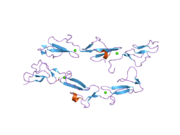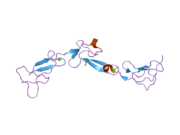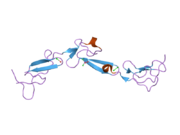EMR2
Template:PBB EGF-like module-containing mucin-like hormone receptor-like 2 also known as CD312 (cluster of differentiation 312) and ADGRE2 is a protein that in humans is encoded by the EMR2 gene. EMR2 is expressed by monocytes/macrophages, dendritic cells and all types of granulocytes.[1] This gene encodes a member of the adhesion-GPCR receptor family expressed predominantly by cells of the immune system.[2] Family members are characterized by an extended extracellular region with a variable number of N-terminal protein modules coupled to a TM7 region via a domain known as the GPCR-Autoproteolysis INducing (GAIN) domain.[3] In the case of EMR2 the N-terminal domains consist of alternatively spliced epidermal growth factor-like (EGF-like) domains. EMR2 is closely related to CD97 with 97% amino-acid identity in the EGF-like domains. The N-terminal fragment (NTF) of EMR2 presents 2-5 EGF-like domains in human.[4] Mice lack the Emr2 gene.[5] This gene is closely linked to the gene encoding egf-like molecule containing mucin-like hormone receptor 3 EMR3 on chromosome 19.
Ligand
Like the related CD97 antigen, the fourth EGF-like domain of EMR2 binds chondroitin sulfate B to mediate cell attachment.[6] However EMR2 does not interact with the complement regulatory protein, decay accelerating factor CD55, unlike CD97, and indicates that these very closely related proteins likely have nonredundant functions.[7]
Signaling
Inositol phosphate (IP3) accumulation assays in overexpressing HEK293 cells have demonstrated coupling of EMR2 to Gα15.[8] EGF-like module-containing mucin-like hormone receptor-like 2 (EMR2) is an adhesion GPCR that undergoes GPS autoproteolysis before being trafficked to the plasma membrane.[9] Further, distribution, translocation, co-localization of the N-terminal fragment (NTF) and N-terminal fragment (CTF) of EMR2 within lipid rafts may affect cell signaling.[10] Mutations in the GPS have shown that EMR2 does not need to undergo autoproteolysis to be trafficked, but loses function. EMR2 has been shown to be necessary for in vitro cell migration. Upon cleavage the N-terminus has been shown to associate with the 7TM, but to also dissociate, giving two possible functions. When the N-terminus dissociates it can be found in lipid rafts. Additionally, the cleaved EMR2 protein 7TM has been found to associate with EMR4 N-terminus.
Function
The expression of EMR2 and CD97 on activated lymphocytes and myeloid cells promotes binding with their ligand chondroitin sulfate B on peripheral B cells, indicating a role in leukocyte interaction.[11] The interaction between EMR2 and chondroitin sulfate B in inflamed rheumatoid synovial tissue suggests a role of the receptors in the recruitment and retention of leukocytes in synovium of arthritis patients.[12] Upon neutrophil activation, EMR2 rapidly moves to membrane ruffles and the leading edge of the cell. Additionally, ligation of EMR2 by antibody promotes neutrophil and macrophage effector functions suggesting a role in potentiating inflammatory responses.[13][14]
See also
References
- ^ Lin HH, Stacey M, Hamann J, Gordon S, McKnight AJ (Jul 2000). "Human EMR2, a novel EGF-TM7 molecule on chromosome 19p13.1, is closely related to CD97". Genomics. 67 (2): 188–200. doi:10.1006/geno.2000.6238. PMID 10903844.
- ^ Stacey M, Yona S (2011). Adhesion-GPCRs: Structure to Function (Advances in Experimental Medicine and Biology). Berlin: Springer. ISBN 1-4419-7912-3.
- ^ Araç D, Boucard AA, Bolliger MF, Nguyen J, Soltis SM, Südhof TC, Brunger AT (Mar 2012). "A novel evolutionarily conserved domain of cell-adhesion GPCRs mediates autoproteolysis". The EMBO Journal. 31 (6): 1364–78. doi:10.1038/emboj.2012.26. PMC 3321182. PMID 22333914.
- ^ Gordon S, Hamann J, Lin HH, Stacey M (Sep 2011). "F4/80 and the related adhesion-GPCRs". European Journal of Immunology. 41 (9): 2472–6. doi:10.1002/eji.201141715. PMID 21952799.
- ^ Kwakkenbos MJ, Matmati M, Madsen O, Pouwels W, Wang Y, Bontrop RE, Heidt PJ, Hoek RM, Hamann J (Dec 2006). "An unusual mode of concerted evolution of the EGF-TM7 receptor chimera EMR2". FASEB Journal. 20 (14): 2582–4. doi:10.1096/fj.06-6500fje. PMID 17068111.
{{cite journal}}: CS1 maint: unflagged free DOI (link) - ^ Stacey M, Chang GW, Davies JQ, Kwakkenbos MJ, Sanderson RD, Hamann J, Gordon S, Lin HH (Oct 2003). "The epidermal growth factor-like domains of the human EMR2 receptor mediate cell attachment through chondroitin sulfate glycosaminoglycans". Blood. 102 (8): 2916–24. doi:10.1182/blood-2002-11-3540. PMID 12829604.
- ^ Kwakkenbos MJ, Chang GW, Lin HH, Pouwels W, de Jong EC, van Lier RA, Gordon S, Hamann J (May 2002). "The human EGF-TM7 family member EMR2 is a heterodimeric receptor expressed on myeloid cells". Journal of Leukocyte Biology. 71 (5): 854–62. PMID 11994511.
- ^ Gupte J, Swaminath G, Danao J, Tian H, Li Y, Wu X (Apr 2012). "Signaling property study of adhesion G-protein-coupled receptors". FEBS Letters. 586 (8): 1214–9. doi:10.1016/j.febslet.2012.03.014. PMID 22575658.
- ^ Lin HH, Chang GW, Davies JQ, Stacey M, Harris J, Gordon S (Jul 2004). "Autocatalytic cleavage of the EMR2 receptor occurs at a conserved G protein-coupled receptor proteolytic site motif". The Journal of Biological Chemistry. 279 (30): 31823–32. doi:10.1074/jbc.M402974200. PMID 15150276.
{{cite journal}}: CS1 maint: unflagged free DOI (link) - ^ Huang YS, Chiang NY, Hu CH, Hsiao CC, Cheng KF, Tsai WP, Yona S, Stacey M, Gordon S, Chang GW, Lin HH (Apr 2012). "Activation of myeloid cell-specific adhesion class G protein-coupled receptor EMR2 via ligation-induced translocation and interaction of receptor subunits in lipid raft microdomains". Molecular and Cellular Biology. 32 (8): 1408–20. doi:10.1128/MCB.06557-11. PMID 22310662.
- ^ Kwakkenbos MJ, Pouwels W, Matmati M, Stacey M, Lin HH, Gordon S, van Lier RA, Hamann J (Jan 2005). "Expression of the largest CD97 and EMR2 isoforms on leukocytes facilitates a specific interaction with chondroitin sulfate on B cells". Journal of Leukocyte Biology. 77 (1): 112–9. doi:10.1189/jlb.0704402. PMID 15498814.
- ^ Kop EN, Kwakkenbos MJ, Teske GJ, Kraan MC, Smeets TJ, Stacey M, Lin HH, Tak PP, Hamann J (Feb 2005). "Identification of the epidermal growth factor-TM7 receptor EMR2 and its ligand dermatan sulfate in rheumatoid synovial tissue". Arthritis and Rheumatism. 52 (2): 442–50. doi:10.1002/art.20788. PMID 15693006.
- ^ Yona S, Lin HH, Dri P, Davies JQ, Hayhoe RP, Lewis SM, Heinsbroek SE, Brown KA, Perretti M, Hamann J, Treacher DF, Gordon S, Stacey M (Mar 2008). "Ligation of the adhesion-GPCR EMR2 regulates human neutrophil function". FASEB Journal. 22 (3): 741–51. doi:10.1096/fj.07-9435com. PMID 17928360.
{{cite journal}}: CS1 maint: unflagged free DOI (link) - ^ Huang YS, Chiang NY, Hu CH, Hsiao CC, Cheng KF, Tsai WP, Yona S, Stacey M, Gordon S, Chang GW, Lin HH (Apr 2012). "Activation of myeloid cell-specific adhesion class G protein-coupled receptor EMR2 via ligation-induced translocation and interaction of receptor subunits in lipid raft microdomains". Molecular and Cellular Biology. 32 (8): 1408–20. doi:10.1128/MCB.06557-11. PMID 22310662.



